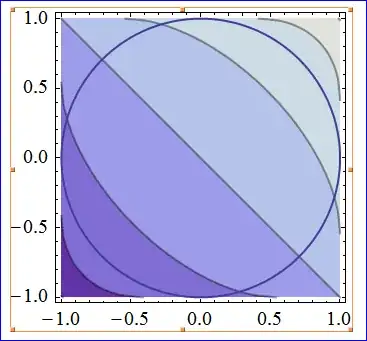Using this, $\displaystyle-\frac\pi2\leq \arcsin z\le\frac\pi2 $ for $-1\le z\le1$
So, $\displaystyle-\pi\le\arcsin x+\arcsin y\le\pi$
Again, $\displaystyle\arcsin x+\arcsin y=
\begin{cases}
\\-\pi- \arcsin(x\sqrt{1-y^2}+y\sqrt{1-x^2})& \mbox{if } -\pi\le\arcsin x+\arcsin y<-\frac\pi2\\
\arcsin(x\sqrt{1-y^2}+y\sqrt{1-x^2}) &\mbox{if } -\frac\pi2\le\arcsin x+\arcsin y\le\frac\pi2 \\
\pi- \arcsin(x\sqrt{1-y^2}+y\sqrt{1-x^2})& \mbox{if }\frac\pi2<\arcsin x+\arcsin y\le\pi \end{cases} $
and as like other trigonometric ratios are $\ge0$ for the angles in $\left[0,\frac\pi2\right]$
So, $\displaystyle\arcsin z\begin{cases}\text{lies in } \left[0,\frac\pi2\right] &\mbox{if } z\ge0 \\
\text{lies in } \left[-\frac\pi2,0\right] & \mbox{if } z<0 \end{cases} $
Case $(i):$
Observe that if $\displaystyle x\cdot y<0\ \ \ \ (1)$ i.e., $x,y$ are of opposite sign, $\displaystyle -\frac\pi2\le\arcsin x+\arcsin y\le\frac\pi2$
Case $(ii):$
If $x>0,y>0$ $\displaystyle \arcsin x+\arcsin y$ will be $\displaystyle \le\frac\pi2$ according as
$\displaystyle \arcsin x\le\frac\pi2-\arcsin y$
But as $\displaystyle\arcsin y+\arccos y=\frac\pi2,$ we need $\displaystyle \arcsin x\le\arccos y$
Again as the principal value of inverse cosine ratio lies in $\in[0,\pi],$
$\displaystyle\arccos y=\arcsin(+\sqrt{1-y^2})\implies \arcsin x\le\arcsin\sqrt{1-y^2}$
Now as sine ratio is increasing in $\displaystyle \left[0,\frac\pi2\right],$ we need $\displaystyle x\le\sqrt{1-y^2}\iff x^2\le1-y^2$ as $x,y>0$
$\displaystyle\implies x^2+y^2\le1 \ \ \ \ (2)$
So, $(1),(2)$ are the required condition for $\displaystyle \arcsin x+\arcsin y\le\frac\pi2$
Case $(iii):$
Now as $\displaystyle-\frac\pi2\arcsin(-u)\le\frac\pi2 \iff -\frac\pi2\arcsin(u)\le\frac\pi2$
$\arcsin(-u)=-\arcsin u$
Use this fact to find the similar condition when $x<0,y<0$ setting $x=-X,y=-Y$

But I think it's pretty fine now. Thanks!
– Parth Thakkar Feb 13 '14 at 07:28$$\iff\arcsin x>\dfrac\pi2-\arcsin y=\arccos(y)$$
Now for $y\ge0,$ $$\arccos(y)=\arcsin\sqrt{1-y^2}$$
So, we need $$\arcsin(x)>\arcsin\sqrt{1-y^2}$$
As $\arcsin(x)$ is increasing function, $$x>\sqrt{1-y^2}\implies x^2>1-y^2$$
– lab bhattacharjee May 08 '20 at 13:55